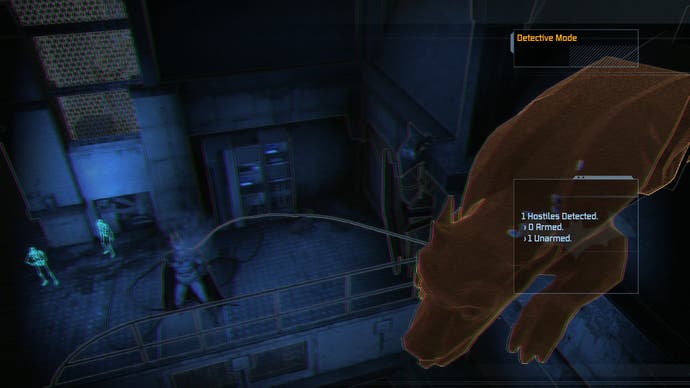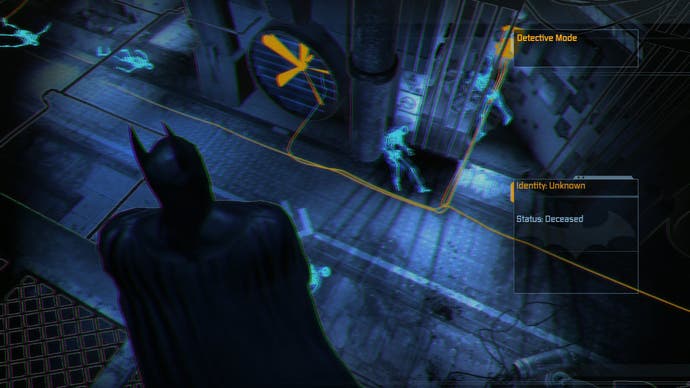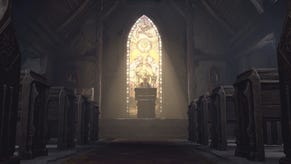TriOviz 3D: Too good to be true?
Assessing the new system in Batman: GOTY Edition.
However, there are clear disadvantages in adopting a 3D approach based on the Z-buffer over and above the basic fact that the game is still essentially rendering the viewpoint for just one eye. Chief amongst them is that transparency effects aren't rendered in the depth buffer, so they won't show up as a 3D effect on-screen. So the danger there is that particle effects and explosions - sometimes the most spectacular parts of a game - will look flat as a consequence of limitations in the basic concept.
"Sure, there are some limitations based on what is and what is not written in the depth buffer, but there are also solutions to work around those," Arragon says confidently.
"I'll let you play through Batman: Arkham Asylum GOTY edition to decide for yourself whether particles and explosions look good or not. Be sure to take a look at the detective vision mode too."
And decide I have. Having spent a couple of days with both the PlayStation 3 and Xbox 360 versions of the Game of the Year rendition of Batman: Arkham Asylum, my personal verdict is that while TriOviz offers up an interesting implementation of 3D, there are still some fundamental obstacles that ensure that the system doesn't quite live up to the claims being made for it.
However, Arragon's suggestion to try out the detective vision mode is a really good one: in this mode, the 3D effect is clear, unambiguous and looks rather smart. The flat colour and vector-style appearance suits the TriOviz technology remarkably well.
After the initial appreciation of the depth TriOViz offers once your eyes have adjusted, detective mode is the highlight of the whole endevour. It suggests that games that take into account TriOviz at the conceptualisation stage could benefit far more than tacking it on to an existing, completed game. It says to me that there's something here that's worth pursuing.




However, it's a bit difficult to process the claims about retaining the original colour palette when you have green and pink pieces of plastic covering your eyes: not surprisingly the colour balance feels very different to playing the game in 2D, so I'll assume that this claim is related to non-glasses viewing. With glasses donned, I found that it took a while for my eyes to "acclimatise" to any given scene, and when you moved into a new area with a new colour scheme or brightness level the process began anew.
Often, the pink and green fringes on objects were all too evident and sometimes the 3D effect simply didn't seem to work for me at all on the entire scene. I tried the game on two displays, fiddled with the colour balance on both in an effort to bring the pinks and greens closer to the lens colours and while the situation was improved I was never completely happy with the effect outside of the detective mode. I was left wondering if some kind of more involved in-game calibration system could have helped or whether we're just dealing with the inherent limitations of an optical illusion.
Other minor issues concerned the location of the HUD in 3D space, and the implementation of those pesky transparencies. Particles and explosions don't stay so long on-screen so any issues in implementation don't tend to register, but transparent textures such as the Joker's arrows on the ground and smiley-face graffiti do - and they don't look so great.
At the end of the day, using colour-filtered glasses is probably going to result in a variable experience depending on the individual. Let's not forget that this is not true stereoscopy, it's essentially a system that is trying to fool the human eye. Clearly TriOviz is a far cheaper alternative to buying a top-end 3D TV and active shutter glasses, and there is an added sense of depth that can look impressive, but having used Sony's proper stereoscopic 3D system and NVIDIA 3D Vision, there is little comparison. As a strong 3D advocate, I wanted TriOviz to look great. The full-on systems just do.
However, TriOviz retains the advantages it possesses in the PC space, where there are many other competing 3D systems. In addition to NVIDIA 3D Vision, at GDC I also had the chance to check out a new implementation called Triple-D, which was OK, but limited to DirectX 9-only and with no shadows. The version of DiRT 2 I saw looked decent enough in first-person mode, but in third-person the lack of shadows made the car look like it was floating in mid-air.
"We have a DX10 version working, and I am not aware of limitations on the PC side," assures Alexis Arragon. "Again, because we're at the software level, we do not have the barrier of that 'lack of X seen in Y driver solution'…"
NVIDIA's 3D Vision system seems to be gaining traction though, with the GPU vendor expanding its range of games all the time, and set to offer forthcoming compatibility for triple-screen set-ups, similar to AMD's EyeFinity but with an added dimension.
"While 3D is gaining a lot of momentum in Hollywood, we know that gamers are still a little sceptical, waiting to see a real, practical solution," says Arragon.
"With all the 120Hz monitors, polarised glasses, the shutter glasses, the old anaglyph curse and the likes, it's all very confusing. There's no standard yet and every quality solution on the market currently requires consumers to spend a fair amount of money for specific equipment. Arguably, 3D Vision does more dramatic 3D, but they have their engineers re-crafting the PC version of those games for a neat effect. Our solution does the job by itself and we do not hit the player with a $600 price tag."
Batman: Arkham Asylum - Game of the Year Edition is out now for PC, PS3 and Xbox 360. Check out our original Batman: Arkham Asylum review to see why it's worth checking out.







